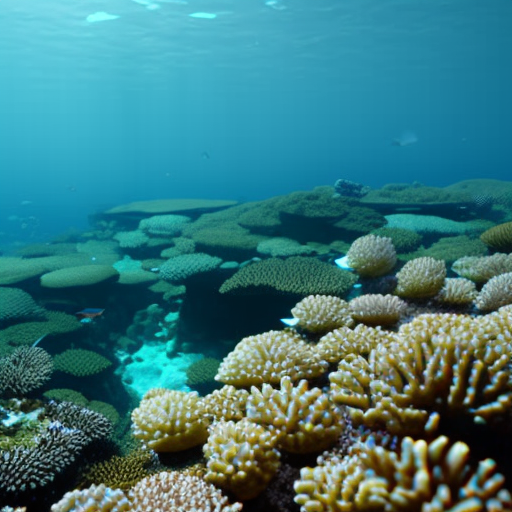
Confirmation of Fourth Global Mass Coral Bleaching Event
This report highlights the confirmation of the fourth global mass coral bleaching event by the National Oceanic and Atmospheric Administration’s (NOAA) Coral Reef Watch (CRW) of the United States and the International Coral Reef Initiative (ICRI). This event occurred between February 2023 and April 2024, affecting corals in 53 countries, territories, and local economies across five different ocean/sea basins.
Background
This is the second such event in the last 10 years, coinciding with unprecedented heat in global oceans during 2023 and 2024. The previous event lasted from 2014 to 2017. The CRW declares a global mass coral bleaching event when it records or receives inputs of coral bleaching from all ocean basins.
Understanding Coral Bleaching
Hard corals, which have a tough shell covering them, are marine animals that form symbiotic relationships with single-celled algae. These algae grow on the coral’s shell, giving them their characteristic color. When sea surface temperatures and ocean heat rise, the algae die off, causing the corals to turn white. This process is known as “bleaching.” Bleached corals become vulnerable to diseases and may eventually die.
Sustainable Development Goals (SDGs)
- SDG 14: Life Below Water – Coral reefs are home to millions of marine animals and plants, making them crucial for biodiversity conservation.
- SDG 15: Life on Land – Coral reefs support around 25% of all marine species during some part of their life cycle.
Threats to Coral Reefs
- Increasing sea surface temperatures and extensive marine heatwaves
- Ocean acidification
- Marine pollution
Impact of Coral Reef Loss
When corals die, other marine species that depend on them for shelter, food, and ecosystem services also suffer. Algae often take over these ecosystems in the absence of coral reefs.
Record-High Temperatures
The year 2023 was the hottest on record for both the atmosphere and the oceans. The El Nino conditions in the equatorial Pacific Ocean contributed to the general trend of warming over land and oceans. Ocean heating and mass coral bleaching are closely tied to the occurrence of El Nino events.
Predictions for the Future
Climate models suggest that bleaching events may become an annual occurrence for most reefs by 2040-2050. Long-term data on coral reef condition are crucial for quantifying coral mortality, tracking recovery, and identifying areas that require further protection or intervention.
References
- Bleached to death
- Fourth global mass coral bleaching? Great Barrier Reef severely affected, corals seen dying
SDGs, Targets, and Indicators
1. Which SDGs are addressed or connected to the issues highlighted in the article?
- SDG 14: Life Below Water – This goal focuses on the conservation and sustainable use of oceans, seas, and marine resources.
- SDG 13: Climate Action – This goal addresses the urgent need to combat climate change and its impacts.
2. What specific targets under those SDGs can be identified based on the article’s content?
- SDG 14.2: By 2020, sustainably manage and protect marine and coastal ecosystems to avoid significant adverse impacts, including by strengthening their resilience and taking action for their restoration, to achieve healthy and productive oceans.
- SDG 13.3: Improve education, awareness-raising, and human and institutional capacity on climate change mitigation, adaptation, impact reduction, and early warning.
3. Are there any indicators mentioned or implied in the article that can be used to measure progress towards the identified targets?
- Indicator for SDG 14.2: Percentage of coral reefs showing no signs of bleaching or damage.
- Indicator for SDG 13.3: Number of people educated or trained on climate change mitigation and adaptation measures.
The article highlights the global mass coral bleaching event, which directly relates to SDG 14 (Life Below Water). The bleaching of corals is a result of rising sea surface temperatures and extensive marine heatwaves, which are connected to climate change (SDG 13 – Climate Action). The targets identified are relevant to these issues, as they focus on the sustainable management and protection of marine ecosystems (SDG 14.2) and the improvement of education and awareness on climate change (SDG 13.3). The indicators mentioned in the article, such as the percentage of coral reefs showing no signs of bleaching or damage and the number of people educated or trained on climate change mitigation and adaptation measures, can be used to measure progress towards these targets.
4. Table: SDGs, Targets, and Indicators
| SDGs | Targets | Indicators |
|---|---|---|
| SDG 14: Life Below Water | 14.2: By 2020, sustainably manage and protect marine and coastal ecosystems to avoid significant adverse impacts, including by strengthening their resilience and taking action for their restoration, to achieve healthy and productive oceans. | Percentage of coral reefs showing no signs of bleaching or damage. |
| SDG 13: Climate Action | 13.3: Improve education, awareness-raising, and human and institutional capacity on climate change mitigation, adaptation, impact reduction, and early warning. | Number of people educated or trained on climate change mitigation and adaptation measures. |
Behold! This splendid article springs forth from the wellspring of knowledge, shaped by a wondrous proprietary AI technology that delved into a vast ocean of data, illuminating the path towards the Sustainable Development Goals. Remember that all rights are reserved by SDG Investors LLC, empowering us to champion progress together.
Source: downtoearth.org.in

Join us, as fellow seekers of change, on a transformative journey at https://sdgtalks.ai/welcome, where you can become a member and actively contribute to shaping a brighter future.






